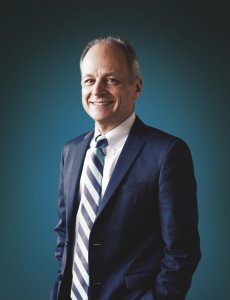A Conversation with the University of Toronto President Meric Gertler
- Caifu Magazine | by Millie Lou
- EN
 aww
aww
Meric Gertler,the President of University of Toronto
Following five years as the University of Toronto’s Dean of Faculty of Arts and Science, Canadian Meric Gertler took the president’s office in November 2013. Since then, he has focused on three priorities: (1) leverage urban location; (2) deepen key international partnerships; and (3) reinvent undergraduate education. I recently caught up with President Gertler to talk about how the university is progressing on those three fronts, particularly the University of Toronto’s affiliation with Chinese partners.
CAIFU: Tell me a bit about yourself, your background and how you became the U of T president? MG: I’ve been a professor at the University of Toronto for over 30 years. My interest has been in cities and how they develop and grow with a particular focus on the economies of cities. I’ve done work on these issues both in Canada and around the world, in Europe, the United States, Asia and beyond. So, I’ve always been interested in the fate of cities. One of those issues is really the role that universities play on how to make cities dynamic and resilient. Now that I am the president of the University of Toronto, I actually have an opportunity to put ideas into practice and to really forge a stronger connection between the city and the university. Before I became the president, I was the Dean of the Faculty of Arts and Science. It’s the largest faculty at the university. In fact, it’s larger than many entire universities just on its own. It was a great warm-up act for what I’m doing now.
 CAIFUCAIFU: When you started out as a lecturer back in the 1980s, did you think you were going to become president of the university one day?
CAIFUCAIFU: When you started out as a lecturer back in the 1980s, did you think you were going to become president of the university one day?
MG: Absolutely not! Academic administration was not what I had in mind. The more I had a taste of it though, the more I found it satisfying in ways that I did not expect. For example, you can have a tangible effect on the experience and well being of many students and faculty and create the best conditions for them to thrive. And that’s really satisfying. It’s also the kind of work where you can see your results quickly. Sometimes when you are working on a research project, it can take five years or more to see results. So it’s satisfying to see the impact of your work sooner.
CAIFU: Can you pinpoint a time when you knew academic administration was where you’d like to be?
MG: Probably when I was entering the Dean’s office of the arts and science. I was a reluctant entrance, I had to be convinced. I had to have my arm twisted. But once I got there, I recognized how much fun it was to work directly with other smart people. Also you come into contact in those roles with people outside of your home discipline, you really begin to appreciate just how good your university is in so many different fields. And it’s actually kind of fun to you work with people with completely different backgrounds but who are very, very good at what they do.
CAIFU: In your installation speech, you talked about Three Priorities. Can you give us an update on the Three Priorities today? 
MG: I’ve done a number of things. For leveraging our location, we appointed a special advisor on urban engagement whose role is to connect students and faculty to potential partners outside the university. We are frequently approached by the city who are looking for experts to help them address key issues such as transportation, poverty or the environment, but people do not know which door to knock on. So the role of my special advisor is to be the one-stop shopping broker who can connect outsiders to insiders. On the notion of deepening international engagement, we are doing a number of things. First of all, we have opened an office in Beijing. We have a staff of three or four people in Beijing working to connect our faculty and students to Chinese partners. I think opening an office was a signal to our Chinese partners that we are very serious about engaging more closely with them. There is already a lot of business passing through that office for us. One of the interesting things we started to do is to form three- or four-way partnerships with other great universities around the world. For example, we have a three- or four-way partnership with us, Peking University, University College London, and possibly IIT Bombay, focusing on cities and urban development challenges. We’re finding that this is the kind emerging pattern of international engagement that many good universities are moving to adopt. And as far as the third priority goes -- reinventing undergraduate education -- we are moving ahead on several different fronts. We are expanding opportunities for students to work in the city with community groups and this ties back to the first priority. We are also creating more research opportunities for our students. We know students choose University of Toronto because of our reputation as a research powerhouse. And so we’ve been working hard to expand the number of ways in which an undergraduate can get involved in that research enterprise working directly with faculty. Another area we are quite active in is figuring out how new teaching and learning technology, particularly digital technology, can enhance the classroom experience. In some cases it might be able to replace the classroom experience. But what we’ve learned over a few years is that there is more excitement around those tools being used to improve the classroom experience rather than replace it entirely.
CAIFU: Going back to the second priority. Can you please elaborate on the types of partnerships with China?
MG: We’ve got university wide partnerships with Peking University, Tsinghua University, Fudan University, Zhejiang University, Shanghai Jiaotong University and Shandong University. We also have a great agreement recently renewed with China Scholarship council to foster mobility of Chinese students to Canada. Areas of particular interest include medicine, engineering, public health, cities and urban environments. We are also very pleased with an agreement recently signed between the Faculty of Applied Science and Engineering and Huawei, a research agreement. I also serve on the international academic advisory committee for the Yenching Academy at Peking University. It’s a new program set up at Peking University to attract the best scholars from around the world to study in China for a year with a focus on Chinese studies, whether it’s in business, politics or the arts. This year, in their first cohort, they brought in 75 students and in the second cohort they are bringing in 100 students. I was honoured to be invited to serve on the international advisory committee for that new program. So this is another way we are deepening the connection. We just recently hosted a delegation from Shanghai Jiaotong University, who came to Toronto to talk about deepening our partnership. Shanghai Jiaotong University is about to establish a new institute of urban governance. And University of Toronto is about to establish a new school of cities. So we discovered another area of common strength and we expect to be doing more in joint research and teaching in that area.
CAIFU: What’s the biggest challenge you had to overcome as president?
MG: One of the challenges, which turned into a huge success, was figuring out how to attract international students to the University of Toronto. We couldn't figure out why international enrollment was so low. We realized that we needed to do a better job of marketing ourselves around the world. Our profile was not very high. We really did invest an awful lot in communication strategies in recruitment and focusing on selective markets, including China, which has been a spectacular success for us.
CAIFU: What was considered low international enrollment?
MG: In as recent as the late 1990s, we were around 3 percent international for undergraduate students. We are now up well over 20 percent. Right now, we have about 8,000 undergraduates from China and close to 1,000 Chinese graduate students One of the mechanisms we use to attract Chinese students is a very innovative program called Green Path, which brings in Chinese students for about three months over the summer to prepare them for entry into first year undergraduate studies. This program helps them become acclimatized to the new surroundings and the new culture and helps them improve their written and spoken english. They already have high enough scores to get in, but we want to make sure that they are really setup to excel. This has proven to be hugely popular. We’ve partnered with many great high schools in China in order to identify great students to enter the University of Toronto.
CAIFU: And the Green Path program is just for China?
MG: Yes, that’s just for China. It’s based at our Scarborough Campus. We have three campuses. We find that that the Scarborough campus is particularly attractive to students from China because it's a little bit smaller. It’s 13,000 students, soon to be 14,000, which is a much smaller subset to a much larger university. It gives them access to everything that the University of Toronto has to offer but it also provides a smaller, more supportive community that really appeals to them.
CAIFU: How do you spend your downtime?
MG: In Toronto, because it’s such a diverse place where over 50 percent of people who live in this region were born outside of Canada, we have the foods of the world here on our doorstep. I just love going to different neighbourhoods in the city and discovering some great little restaurant and an entirely new cuisine. So I really take advantage of everything Toronto has to offer, at least as time allows.
CAIFU: When you travel abroad to places like China, do you enjoy eating local cuisines?
MG: I love doing that. In fact, when I was preparing for my first trip to China as president, we actually sent out a message to Chinese students at the University of Toronto saying, “The president is going to Beijing and Shanghai, where should he eat?” I got a lot of great suggestions. Of course when I got there, I took photographs and put them on instagram so people can see where I went. I had fabulous Peking duck in Beijing and also great hot pot meals.















